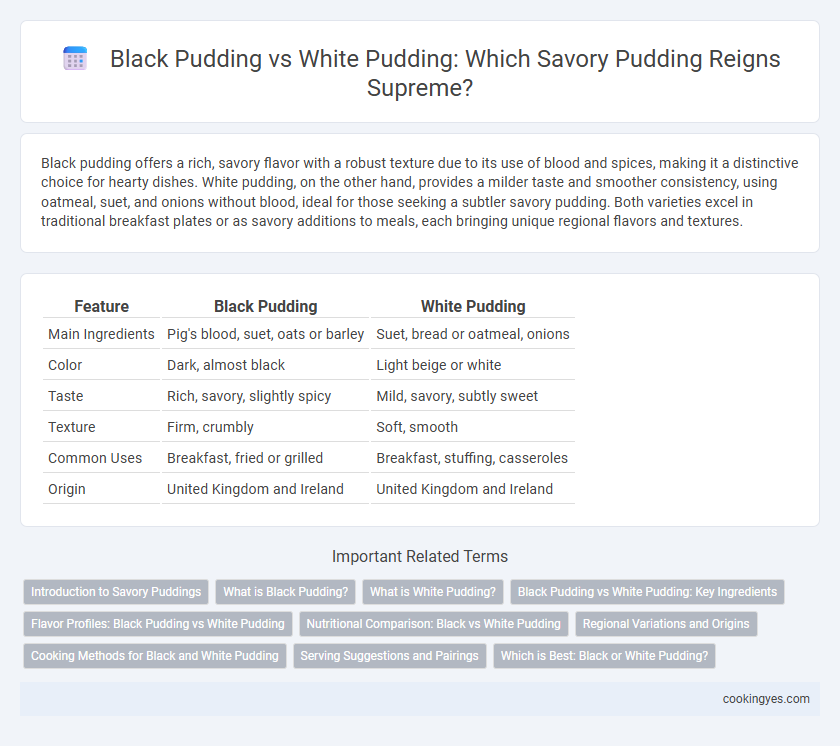Black pudding offers a rich, savory flavor with a robust texture due to its use of blood and spices, making it a distinctive choice for hearty dishes. White pudding, on the other hand, provides a milder taste and smoother consistency, using oatmeal, suet, and onions without blood, ideal for those seeking a subtler savory pudding. Both varieties excel in traditional breakfast plates or as savory additions to meals, each bringing unique regional flavors and textures.
Table of Comparison
| Feature | Black Pudding | White Pudding |
|---|---|---|
| Main Ingredients | Pig's blood, suet, oats or barley | Suet, bread or oatmeal, onions |
| Color | Dark, almost black | Light beige or white |
| Taste | Rich, savory, slightly spicy | Mild, savory, subtly sweet |
| Texture | Firm, crumbly | Soft, smooth |
| Common Uses | Breakfast, fried or grilled | Breakfast, stuffing, casseroles |
| Origin | United Kingdom and Ireland | United Kingdom and Ireland |
Introduction to Savory Puddings
Savory puddings like black pudding and white pudding are traditional dishes rich in regional variations across the UK and Ireland. Black pudding is primarily made from pig's blood, fat, and oatmeal, offering a rich, iron-packed flavor, whereas white pudding combines suet, oatmeal, and spices without blood, resulting in a milder taste. Both types serve as staple components of hearty breakfasts and are celebrated for their distinct textures and cultural significance in savory cuisine.
What is Black Pudding?
Black pudding is a type of savory blood sausage made primarily from pork blood, fat, and oatmeal or barley, offering a rich, iron-packed flavor. It contrasts with white pudding, which excludes blood and uses similar ingredients like suet and grains, resulting in a milder taste. Black pudding is a traditional delicacy in regions such as the UK and Ireland, valued for its dense texture and nutrient density.
What is White Pudding?
White pudding is a traditional savory pudding popular in Irish and Scottish cuisine, made primarily from pork suet, oatmeal, and breadcrumbs, without the inclusion of blood, distinguishing it from black pudding. It typically contains a blend of spices such as white pepper and nutmeg, contributing to its mild, creamy flavor profile. White pudding is often sliced and fried, served as part of a traditional breakfast alongside black pudding, sausages, and eggs.
Black Pudding vs White Pudding: Key Ingredients
Black pudding is primarily made from pork blood, fat, oatmeal, and suet, giving it a rich, iron-packed flavor and a dense texture. White pudding contains similar ingredients minus the blood, incorporating pork meat, suet, oatmeal, and barley, resulting in a milder taste and lighter color. Both savory puddings reflect traditional Irish and Scottish culinary practices, with their ingredient differences defining their distinct flavors and textures.
Flavor Profiles: Black Pudding vs White Pudding
Black pudding offers a rich, earthy flavor profile with pronounced notes of blood, spices like cloves and nutmeg, and a dense, slightly crumbly texture that enhances savory dishes. White pudding, by contrast, presents a milder, creamier taste dominated by oatmeal, suet, and subtle seasonings, providing a smoother and less intense flavor experience. Both puddings complement savory meals, but black pudding stands out for its bold, robust character, while white pudding appeals with its delicate, comforting palate.
Nutritional Comparison: Black vs White Pudding
Black pudding boasts higher protein and iron content, making it a nutrient-dense option rich in heme iron essential for blood health. White pudding, while lower in fat and calories, offers a milder flavor with fewer vitamins and minerals compared to black pudding. Both varieties provide a good source of energy, but black pudding is generally considered more beneficial for those seeking a nutrient-rich savory pudding.
Regional Variations and Origins
Black pudding, rich in blood and oatmeal, is a traditional savory pudding popular in regions like Ireland, Scotland, and northern England, where recipes often include spices such as black pepper and thyme. White pudding, originating primarily from Ireland and Scotland, omits blood and instead uses suet, oatmeal, and onions, offering a milder flavor and softer texture compared to black pudding. Regional variations reflect local ingredients and culinary traditions, with black pudding favored in Ulster and Lancashire, while white pudding is often associated with southwestern Ireland and parts of Scotland.
Cooking Methods for Black and White Pudding
Black pudding requires careful frying or grilling to achieve a crispy exterior while maintaining its soft, rich interior, often cooked over medium heat to prevent splitting. White pudding benefits from gentle pan-frying or simmering, preserving its delicate texture and subtle flavors without drying out. Both types can also be baked or lightly grilled, but controlling temperature is crucial to avoid curdling or burning.
Serving Suggestions and Pairings
Black pudding, rich in iron and blood-based spices, pairs excellently with sharp flavors like apple sauce, mustard, or tangy chutneys to balance its savory depth. White pudding, milder and made from pork, suet, and oatmeal, complements sweeter accompaniments such as caramelized onions, sauteed apples, or smooth mashed potatoes. Both puddings are traditionally served as part of a hearty breakfast alongside eggs, bacon, and fried bread, enhancing their savory profiles.
Which is Best: Black or White Pudding?
Black pudding, rich in iron and blood sausage tradition, offers a robust, savory flavor favored in many British and Irish breakfasts, while white pudding, made primarily from pork meat, fat, and oatmeal, provides a milder, smoother taste ideal for those preferring less intense spices. Nutritionally, black pudding tends to be higher in protein and minerals, appealing to health-conscious consumers seeking nutrient-dense options. The best choice between black and white pudding depends on personal flavor preference and dietary needs, with black pudding suited for stronger tastes and white pudding catering to subtler palates.
Black pudding vs White pudding for savory puddings Infographic

 cookingyes.com
cookingyes.com